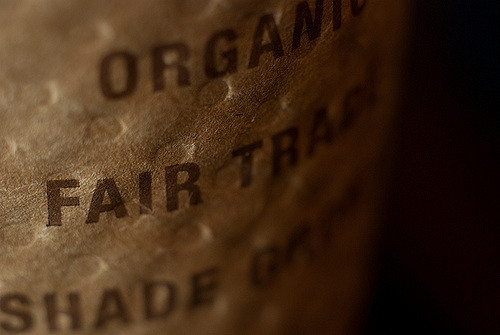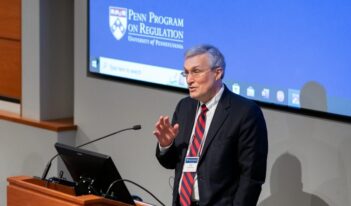
Penn Law Regulation Fellow shares research on costs and compliance underlying transnational regulatory schemes.
Surveying the coffee bean options on display at most grocery stores can be a mystifying experience. In addition to selecting ground or whole-bean coffee, and light or dark roast, many consumers now also encounter an array of stickers and emblems to choose from. Is a sticker noting “rainforest friendly” the right choice? Should it have an emblem signaling protection of migratory birds, Fair Trade, or certified organic?
These questions do not end in the coffee aisle. Private or third-party certifications, as these labels are known, have become a mainstay on many of today’s household goods, from coffee to clothing. Although consumers look for the labels as signals of quality, they usually know relatively little about them.
Often structured as a non-profit supported by member companies, a certifying organization may set standards and train inspectors to monitor participating factories or farms for compliance. The factory or farm usually pays for the inspection itself and some certifying organizations even permit participants to select the individual inspector.
During a recent seminar sponsored by the Penn Program on Regulation (PPR), Shana Starobin, who recently completed her Ph.D. from Duke University’s Nicholas School of the Environment and is currently a PPR fellow, demystified private certification schemes by sharing some of her scholarship on the quality and credibility of the labels. Drawing on findings from her dissertation field work and prior research conducted with David Levi-Faur and Erika Weinthal, Starobin provided attendees at the University of Pennsylvania Law School seminar a more nuanced view of the transnational regulatory regimes underlying private certifications.
Starobin first explained that the purpose of a certified agency or entity is to communicate information to the end customer about a product’s environmental or labor standards. Although lab tests can confirm certain product attributes, such as pesticide-free produce, chemical analysis cannot prove that a coffee farm minimized its impact on migratory birds or that workers operating textile looms enjoy safe working conditions. Third-party certifications emerged to bridge this information gap. Particularly in developing countries, private or third-party certifications substitute for services provided by regulatory agencies in industrialized nations like the United States, such as the U.S. Environmental Protection Agency. Instead of accepting the brand’s own claims at face value, customers can ostensibly rely on an intermediary organization to hold the producer or manufacturer accountable.
Successful third-party certification systems thus rely upon effective enforcement by third-party inspectors, who are often trained by the certifying organization. In a recent paper co-authored with David Levi-Faur of the Hebrew University of Jerusalem, Starobin examined the inspectors’ role in the certification process in the context of a tragic transnational regulatory failure: the 2012 fire at a garment factory in Karachi, Pakistan, which killed 262 people. The facility was a sweatshop, as news accounts later detailed; barred windows left a single door as the only escape option. The factory owners made no changes to the physical plant nor did they offer employees emergency protocols in response to prior fire incidents. Yet just weeks before the blaze, inspectors trained by a third-party private regulator, Social Accountability International, had approved the factory’s working conditions and safety standards.
Levi-Faur and Starobin argue that far too little scholarship has focused on the third-party inspectors. Often, by virtue of their positions and credentials, such private inspectors are simply “presumed credible” by stores carrying certified goods and customers who purchase them. But the Karachi travesty illustrates a structural challenge with third-party regulation: subpar manufacturers or farmers can seek out inept or bribable inspectors. Thus, customers who wish to know whether goods were ethically produced should look beyond the label; understanding the training, assessment, and compensation that SAI’s inspectors receive will shed better light on whether the desired standards are in fact achieved – or simply rubber stamped.
In addition to questioning the caliber and integrity of certification inspections, Starobin encouraged seminar attendees to keep in mind the workers impacted by the private certifications. Are farm laborers or factory workers, the intended beneficiaries of many private certifications, realizing improved labor conditions as a result of these private regulatory schemes? Can small-scale producers afford to participate in a voluntary, third-party certification program?
Starobin cited Fair Trade Certified, perhaps the best known example of a transnational product certification regulatory regime. The Fair Trade Certified label emerged to motivate sustainable environmental and fair labor practices in nations where governments protected neither principle. But compliance itself is costly, Starobin noted. Some small-scale producers may meet every compliant step but find the certification process out of their price range. The cost of certification could include licensing fees, equipment or input changes for farmers, or even attorneys’ fees and translation costs for the application process. Because many private, voluntary certifications follow a “pay to play” model, they may disproportionately benefit those producers that have enough extra capital to pay the certification fees and price out very small-scale farmers
Communicating quality through private label schemes places private actors in the shoes of state-sponsored regulators. Scholars such as Starobin hope that this is only a temporary solution while national governments develop their own regulatory system to enforce labor and environmental standards. As private, voluntary schemes such as Fair Trade Certified have proliferated, however, Starobin’s research makes clear that the labels in the supermarket aisle will be around for a while. Encouraging consumers to consider the strength of a private regulation’s enforcement before defaulting to the most attractive stamp of approval in the coffee aisle may offer one path toward demanding greater credibility from third-party certification schemes.
The image of a Fair Trade sleeve is the property of the Jens Schott Knudsen and is used under a Creative Commons License.



